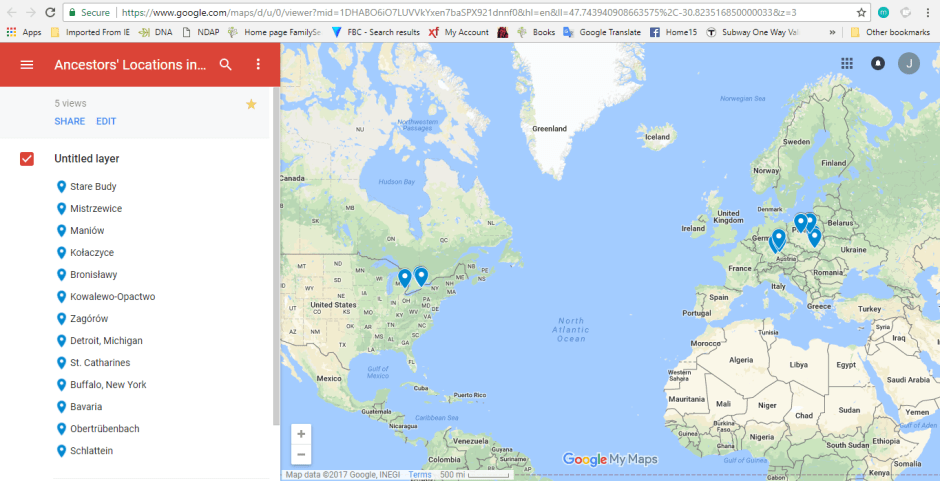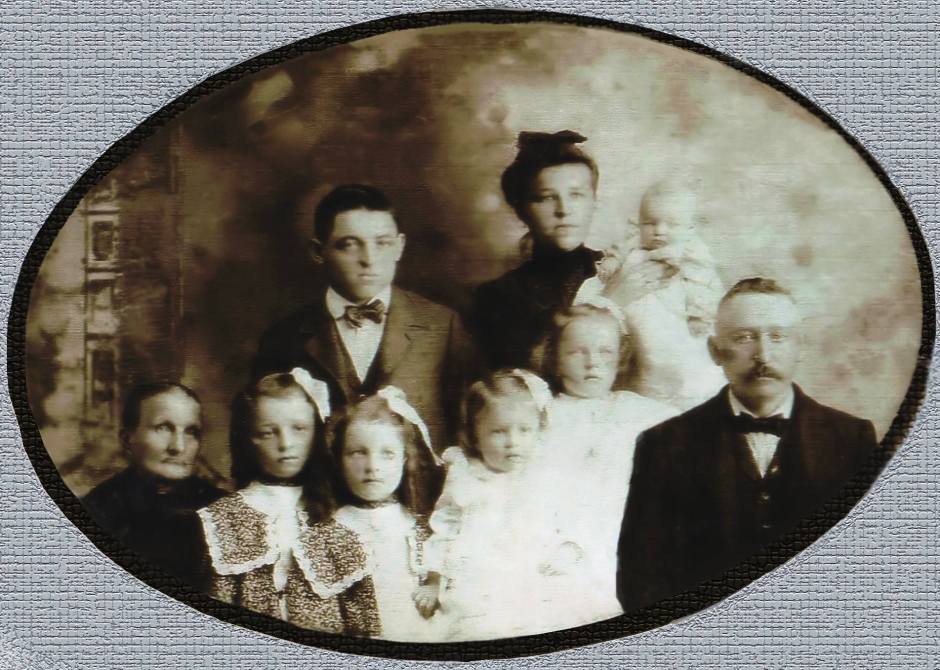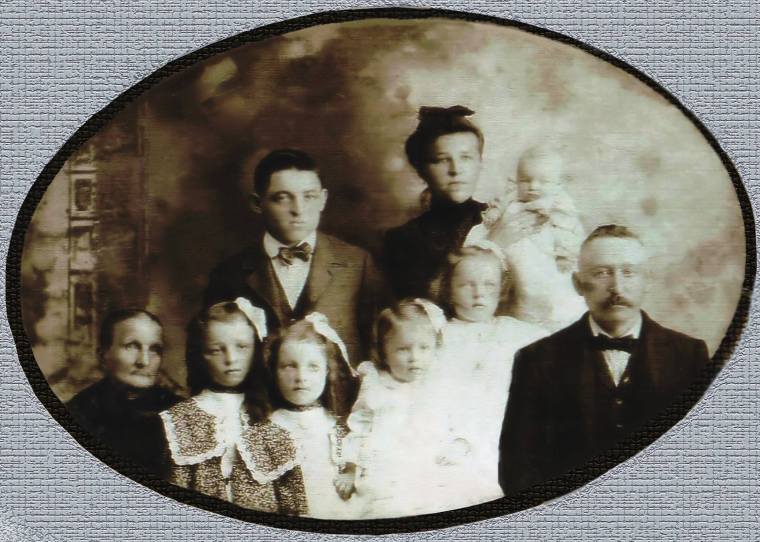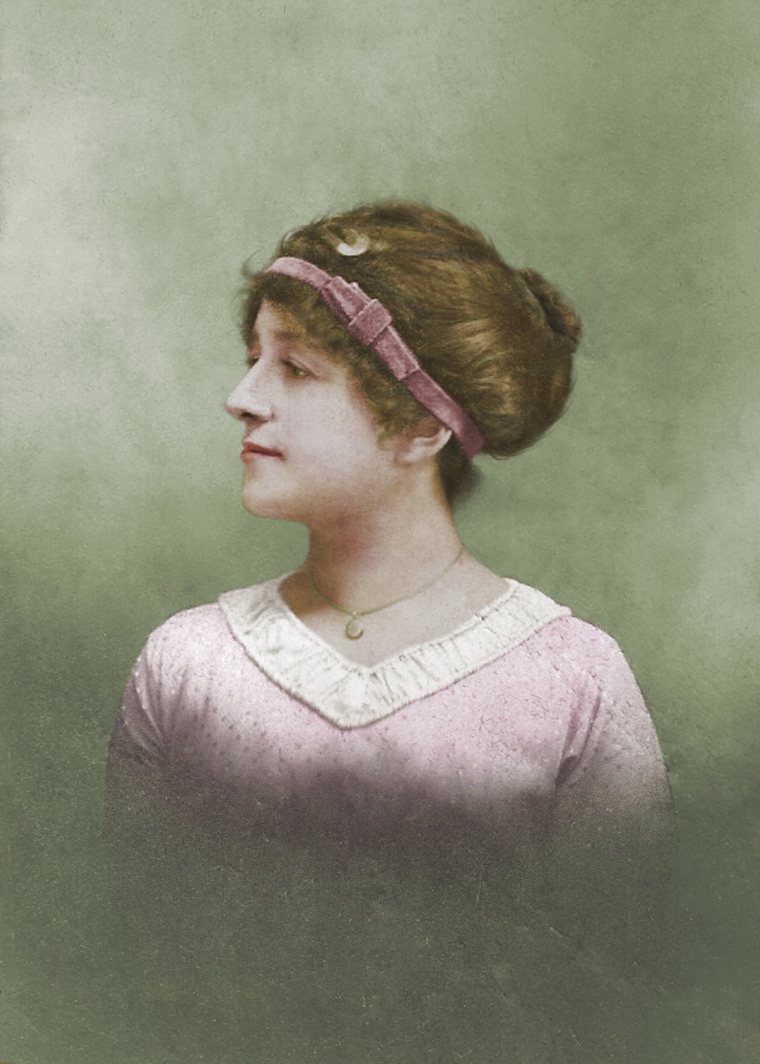Genealogists often think in terms of family timelines, tracing one particular family line through many generations. However, it occurred to me that it might be interesting to examine my family tree in cross section. That is, what was happening in each of my family lines in the year 1857? I chose that year because I wrote recently about my 3x-great-grandparents’s marriage in Roding, Bavaria in 1857, and that got me wondering what my other ancestors were doing in that same year, and where they were living around the world. It turns out this is a pretty useful (and fun!) exercise. I gained new insights into each family group, and it also served to point out deficiencies in my research, and families that I’ve neglected, that I should perhaps plan to spend more time on in 2018. Here, then, is a summary of my ancestral couples who were alive at that time. Although the map in the featured image is not “clickable,” you can use this link to explore that map in greater depth, if you’d like.
Maternal grandfather’s line
In 1857, my 3x-great-grandparents, Michał Zieliński and Antonia (née Ciećwierz) Zielińska, were living in the village of Mistrzewice in Sochaczew County in what was at that time the Królestwo Polskie or Kingdom of Poland, which officially had some autonomy, but was in reality a puppet state of the Russian Empire. They’d been married about four years, although I don’t know the precise date of their marriage because 19th century records for Mistrzewice prior to 1859 were largely destroyed. Michał and Antonina had one daughter, Zofia, who was about 2, and Michał supported his family as a gospodarz, a farmer who owned his own land.1
Meanwhile, in the nearby village of Budy Stare, Sochaczew County, my 3x-great-grandparents Roch Kalota and Agata (née Kurowska) Kalota welcomed their (probably) oldest daughter, my great-great-grandmother, Marianna Kalota, who was born circa 1857. Again, the destruction of records has been a problem for researching this line, but available records tell us that Roch Kalota, too, was a farmer.2
In the south of Poland in 1857, my 3x-great-grandparents on my Klaus line had not yet married. Jakub Klaus was the son of Wawrzyniec (Lawrence) Klaus and Anna Żala or Żola. He was a young man already 27 years of age, but he did not marry his wife, Franciszka, until 1860.3 Franciszka Liguz was the daughter of Wawrzyniec Liguz and Małgorzata Warzecha, age 21 in 1857. Both Franciszka and her husband-to-be, Jakub, lived in the village of Maniów in Dąbrowa County in the Galicia region of the Austrian Empire, and Jakub was described as a famulus, or servant.
Still further south in what is now Poland, my 3x-great-grandparents Jakub Łącki and Anna Ptaszkiewicz were 4 years away from their eventual wedding date.4 In 1857, Jakub was a 22-year-old shoemaker from the village of Kołaczyce in Jasło County in the Austrian Empire, and Anna was the 23-year-old daughter of a shoemaker from the same village.
Maternal grandmother’s line
Heading further north again in Poland, back into Sochaczew County in Russian Poland, my 2x-great-grandparents Ignacy and Antonina (née Naciążek) Zarzycki were about 8 years into their marriage, raising their family in the village of Bronisławy. By 1857, they had three children for whom birth records have been discovered, Marianna,5 Paulina,6 and Tomasz.7 Ignacy was a land-owning farmer who was born in the nearby village of Szwarocin,8 but his wife Antonina’s place of birth remains a mystery.
Moving west now, in 1857 my 3x-great-grandparents Stanisław and Jadwiga (née Dąbrowska) Grzesiak were living in Kowalewo Opactwo, a village that was located in Słupca County at the far western edge of the Russian Empire, within walking distance of the border with Prussia. Ages 51 and 41, respectively, they were already parents to 12 of their 13 children. Stanisław was usually described as a shepherd or a tenant farmer.9
In the nearby town of Zagórów, my 3x-great-grandmother, Wiktoria (née Dębowska) Krawczyńska was living as a 53-year-old widow, having lost her husband Antoni Krawczyński 10 years earlier.10 Antoni had been a shoemaker, and he and Wiktoria were the parents of 8 children, of whom 4 died in infancy. By 1857, the surviving children ranged in age from 27 to 14 — the youngest being my great-great-grandmother, Marianna Krawczyńska.
Paternal grandfather’s line
Meanwhile, in Detroit, Michigan, my 3x-great-grandparents Michael Ruppert and Maria Magdalena Causin were newlyweds in 1857, having married on 12 May of that year.11 Michael had immigrated to the U.S. just four years earlier, at the age of 19, with his parents and siblings.12 The Rupperts were from the village of Heßloch in the Grand Duchy of Hesse-Darmstadt, or what is now Alzey-Worms district in Rhineland-Palatinate, Germany.13 Michael was a carpenter, and he and his family had already begun to use the surname Roberts.14 His wife Maria Magdalena Causin/Casin/Curzon is a bit of a mystery, and will likely be the subject of future blog post, because she doesn’t show up in the records until her marriage in 1857, and her parents’ names are not on her marriage or death records.
In 1857, my 3x-great-grandparents Henry and Catherine (née Grentzinger) Wagner and were also living in Detroit, had been married for 2 years and were parents to their first child, John Wagner.15 Henry was a teamster who had arrived in Detroit about 3 years previously along with his parents and siblings, all immigrants from the village of Roßdorf in the Electorate of Hesse, a state within the German Confederation.16 This was a first marriage for Henry, but a second marriage for Catherine, since she was a young widow after the death of her first husband, Victor Dellinger or Dalmgher.17 In addition to burying her husband some time between 1850-1855, it appears that both of Catherine’s children from that first marriage 18 also died young, since they were not mentioned in the 1860 census in the household of Henry and Catherine Wagner. Catherine herself was an immigrant from Steinsoultz, Haut-Rhin, Alsace, who came to Detroit with her parents and siblings some time between 1830 and 1834.
Across the border and some 225 miles to the east, my 3x-great-grandparents Robert and Elizabeth (née Hodgkinson) Walsh made their home in St. Catharines, Ontario, Canada. In 1857, Elizabeth Walsh was a 39-year-old mother of 5, pregnant with her 6th child, Ellen, who was born in December of that year.19 Elizabeth was the granddaughter and great-granddaughter of United Empire Loyalists, so her family were among the first settlers in St. Catharines. Her husband, Robert Walsh, was a 49-year-old tailor from Ireland whose family origins have proven to be more elusive than his wife’s.
Also living in St. Catharines were my 3x-great-grandparents, Robert and Catherine Dodds. In 1857, Robert was a 40-year-old immigrant from England, usually described as a laborer or farm laborer. Nothing is known about Robert’s family of origin. He married his wife, Catherine, circa 1840, and by 1857 they were the parents of three daughters and three sons.20 Catherine’s origins, and even her maiden name, are unclear. There is evidence that she was born circa 1818 in Martintown, Glengarry, Ontario to parents who were Scottish immigrants or of Scottish extraction, but no birth record or marriage record has yet been discovered for her.
Paternal grandmother’s line
Jacob and Catherine (née Rogg or Rock) Böhringer, my 3x-great-grandparents, were German immigrants from the Black Forest, having lived in the village of Gündelwangen in the Grand Duchy of Baden21 prior to their migration to Buffalo, New York in 1848.22 By 1857, Catherine and Jacob had already buried three of their seven children, including oldest daughter Maria Bertha, who was born in Germany and apparently died on the voyage to America. Jacob was a joiner or a cabinet maker.23
In 1857, my 3x-great-grandparents Joseph Murre and Walburga Maurer were still about 5 years away from their eventual wedding date. They were born and married in Bavaria, Germany, although I have yet to discover their specific place of origin. I don’t know the names of the parents of either Joseph or Walburga. Joseph was a woodworker who was employed in a planing mill in Buffalo, New York in 1870 24 and was later listed as a carpenter in the Buffalo city directory in 1890. He and Walburga arrived in New York on 3 April 1869 with their children Maria, Anna and Johann.25
In October 1857, my 3x-great-grandparents Johann Meier and Anna Maria Urban were married in the parish church in Roding, Bavaria.26 Their first child, Johann Evangelista Meier, was born out of wedlock two years previously although the father was named on the baptismal record with a note that the child was subsequently legitimized. Johann and Anna Maria would go on to have a total of 10 children, 3 of whom migrated to Buffalo, New York.
In 1857, my 4x-great-grandparents, Ulrich Götz or Goetz and Josephine Zinger, were living somewhere in Bavaria and raising their 4-year-old son, Carl Götz, who was my 3x-great-grandfather. Almost nothing is known of this family, including where they lived in Bavaria or the names of Carl’s siblings. Carl grew up to be the second husband of a much older wife, Julia Anna Bäumler, who was already 19 in 1857. Julia had at least one child from a previous relationship, a son, John George Bäumler, who was born in 1858. Julia and Carl married in Bavaria circa 1875, a development which may or may not have influenced John Bäumler’s decision to emigrate from Bavaria to Buffalo, New York in 1876.28 Julia gave birth to her only child with Carl, Anna Götz (my great-great-grandmother), in 1877, and the Götz family eventually followed John Bäumler to Buffalo in 1883. Julia Götz’s death record states that she was born in “Schlattine, Bavaria,” which suggests the village of Schlattein in Neustadt an der Waldnaab, Bavaria, but further research is needed to confirm this location.
So there you have it: a summary of where my ancestors were in the world, and in their lives, in the year 1857. But what about your ancestors? Where were they living, and what were they doing? Is there a more interesting year for your family than 1857? Choose a different year, and tell me your ancestors’ stories!
Selected Sources:
1 Akta stanu cywilnego parafii rzymskokatolickiej w Mistrzewicach, Polskie Towarzystwo Genealogiczne, Metryki.genealodzy.pl, 1875, Małżeństwa, #2, record for Zofia Zielińska and Piotr Malinowski, accessed on 10 November 2017.
2 Akta stanu cywilnego parafii rzymskokatolickiej w Mlodzieszynie, Polskie Towarzystwo Genealogiczne, Metryki.genealodzy.pl, Księga zgonów 1889-1901, 1895, #59, death record for Wojciech Kalota, accessed on 10 November 2017.
3 Roman Catholic Church, St. Mary Magdalene parish (Szczucin, Dąbrowa, Małopolskie, Poland), Księgi metrykalne, 1786-1988, Akta małżeństw 1786-1988, Maniów, 1860, 16 September, marriage record for Jacobus Klaus and Francisca Liguz, Family History Library film # 1958428 Items 7-8.
4 Roman Catholic Church, St. Anne’s Parish (Kołaczyce, Jasło, Podkarpackie, Poland), Śluby, 1826-1889, Stare Kopie, 1861, #11, marriage record for Jacobus Łącki and Anna Ptaszkiewicz.
5 Roman Catholic Church, St. Bartholomew’s parish (Rybno, Sochaczew, Mazowieckie, Poland), Księga urodzeń 1845-1854, 1850, #48, baptismal record for Maryanna Zarzycka.
6 Roman Catholic Church, St. Bartholomew’s parish (Rybno, Sochaczew, Mazowieckie, Poland), Księga urodzeń 1845-1854, 1853, #60, baptismal record for Paulina Zarzycka.
7 Roman Catholic Church, St. Bartholomew’s Parish (Rybno, Sochaczew, Mazowieckie, Poland), Księga urodzeń, 1855-1862, 1856, #48, baptismal record for Tomasz Zarzecki.
8 Roman Catholic Church, St. Bartholomew’s Parish (Rybno, Sochaczew, Mazowieckie, Poland), 1828, #34, baptismal record for Ignacy Zarzycki.
9 Akta stanu cywilnego Parafii Rzymskokatolickiej Kowalewo-Opactwo (pow. słupecki), 1832, marriages, #14, record for Stanisław Grzesiak and Jadwiga Dąbrowska, Szukajwarchiwach, http://www.szukajwarchiwach.pl/, accessed 17 November 2017.
10 Roman Catholic Church, Zagórów parish (Zagórów (Słupca), Poznań, Poland), Kopie księg metrykalnych, 1808-1947, 1843, #137, death record for Antoni Krawczyński.; FHL film #2162134, Item 1, Akta zgonów 1844-1849.
11 Roman Catholic Church, St. Joseph’s parish (Detroit, Wayne, Michigan, USA), “Marriages”, 1857, #15, marriage record for Michael Ruppert and Magdalena Causin.
12 New York, Passenger Lists, 1820-1957 (index and image), record for Franz, Catherine, Michael, Arnold, and Catherine Rupard, S.S. William Tell, arrived 4 March 1853, http://ancestry.com, subscription database, Microfilm Serial: M237, 1820-1897; Microfilm Roll: Roll 123; Line: 51; List Number: 146, accessed 17 November 2017.
13 Roman Catholic Church (Heßloch (Kr. Worms), Hesse, Germany), Kirchenbuch, 1715-1876, 1834, baptismal record for Michael Ruppert, FHL film #948719.
14 1860 U.S. Census (population schedule), Detroit, Wayne, Michigan, p. 142, Michael Roberts and Frank Roberts households, http://ancestry.com, subscription database, accessed 17 November 2017.
15 Michigan, County Marriages, 1820-1940, database, Church of Jesus Christ of Latter-Day Saints, FamilySearch, (https://familysearch.org), database with images, 1855, #11, record for Henry Wagner and Catherine Dellinger, accessed 17 November 2017.
16 New York, Passenger Lists, 1820-1957 (image and transcription), record for Henry, Cath., August, Johnny, Gertrude, and Marianne Wagner, S.S. Erbpring Luidrich August, arrived 29 September 1853 in New York, Microfilm Serial: M237, 1820-1897; Microfilm Roll: Roll 132; Line: 12; List Number: 1010, http://ancestry.com/, subscription database, accessed 17 November 2017.
17 Michigan, County Marriages, 1820-1940, (images and transcriptions), Wayne County, marriage certificates, 1842-1848, v. B, #1733, marriage record for Victor Dellinger and Catherine Grenzinger, 3 February 1846, FamilySearch, https://familysearch.org, accessed 17 November 2017.
, St. Catharines, Lincoln, Canada West (Ontario), Robert Walsh household, item number 2721097, accessed 9 November 2017. http://data2.collectionscanada.gc.ca/1861/jpg/4391560_00231.jpg) 18 1850 U.S. Federal Census (population schedule), Detroit, Wayne, Michigan, page 156B and 157, Victor Dalmgher household, http://ancestry.com, subscription database, accessed 17 November 2017.
18 1850 U.S. Federal Census (population schedule), Detroit, Wayne, Michigan, page 156B and 157, Victor Dalmgher household, http://ancestry.com, subscription database, accessed 17 November 2017. , St. Catharines, Lincoln, Canada West (Ontario), Robert Walsh household, item number 2721097, accessed 9 November 2017. http://data2.collectionscanada.gc.ca/1861/jpg/4391560_00231.jpg)
, St. Catharines, Lincoln, Canada West (Ontario), Robert Walsh household, item number 2721097, accessed 9 November 2017. http://data2.collectionscanada.gc.ca/1861/jpg/4391560_00231.jpg)
, St. Catharines, Lincoln, Canada West (Ontario), Robert Walsh household, item number 2721097, accessed 9 November 2017. http://data2.collectionscanada.gc.ca/1861/jpg/4391560_00231.jpg)
, St. Catharines, Lincoln, Canada West (Ontario), Robert Walsh household, item number 2721097, accessed 9 November 2017. http://data2.collectionscanada.gc.ca/1861/jpg/4391560_00231.jpg)
19 Census of 1861, database, Library and Archives Canada, St. Catharines, Lincoln, Canada West (Ontario), Robert Walsh household, item number 2721097, accessed 17 November 2017.
20 Census of 1861, database, Library and Archives Canada, Grantham, Lincoln, Canada West (Ontario), Library and Archives Canada, Robert Dodds household, Item number 1884852, accessed 17 November 2017.
21 , St. Catharines, Lincoln, Canada West (Ontario), Robert Walsh household, item number 2721097, accessed 9 November 2017. http://data2.collectionscanada.gc.ca/1861/jpg/4391560_00231.jpg)
, St. Catharines, Lincoln, Canada West (Ontario), Robert Walsh household, item number 2721097, accessed 9 November 2017. http://data2.collectionscanada.gc.ca/1861/jpg/4391560_00231.jpg)
, St. Catharines, Lincoln, Canada West (Ontario), Robert Walsh household, item number 2721097, accessed 9 November 2017. http://data2.collectionscanada.gc.ca/1861/jpg/4391560_00231.jpg) Roman Catholic Church, Gündelwangen parish (Gündelwangen, Waldshut, Freiburg, Baden-Württemberg, Germany), Kirchenbuchduplikat, 1810-1869, 1847, baptisms, #4, record for Maria Bertha Rogg, p. 165, with addendum on page 171, Family History Library film #1055226.
Roman Catholic Church, Gündelwangen parish (Gündelwangen, Waldshut, Freiburg, Baden-Württemberg, Germany), Kirchenbuchduplikat, 1810-1869, 1847, baptisms, #4, record for Maria Bertha Rogg, p. 165, with addendum on page 171, Family History Library film #1055226.
22 Passenger and Immigration Lists, 1820-1850, record for Jacob Behringer, Catherine, and Marie Behringer, S.S. Admiral, arrived 4 November 1848 in New York, http://ancestry.com/, subscription database, accessed 17 November 2017.
23 1860 United States Federal Census (population schedule), 7th Ward Buffalo, Erie, New York, p. 77, Jacob Barringer household, http://familysearch.org, accessed 17 November 2017.
24 1860 United States Federal Census (population schedule), 7th Ward Buffalo, Erie, New York, p. 73, Joseph Murri household, http://familysearch.org, accessed 17 November 2017.
25 Passenger Lists, 1820-1957 (image and transcription), record for Joseph, Walburga, Anna, Marie, and Johann Muri, S.S. Hansa, arrived 3 April 1869 in New York, Microfilm Serial: M237, 1820-1897; Microfilm Roll: Roll 308; Line: 38; List Number: 292. http://ancestry.com/, subscription database, accessed 17 November 2017.
26 BZAR, Roman Catholic Church, St. Pancrus parish (Roding, Cham, Oberpfalz, Germany), Marriage record for Johann Maier and Anna M. Urban, 27 October 1857, Vol. 27, page 3 MF 573.
271900 United States Federal Census (population schedule), Buffalo, Erie, New York, E.D. 107, Sheet 16B, Charles Goetz household, https://.ancestry.com, subscription database, accessed 17 November 2017.
28 1900 United States Federal Census (population schedule), Gainesville, Wyoming, New York, E.D. 122, Sheet 9A, John Baumler household, https://.ancestry.com, subscription database, accessed 17 November 2017.
© Julie Roberts Szczepankiewicz 2017
, St. Catharines, Lincoln, Canada West (Ontario), Robert Walsh household, item number 2721097, accessed 9 November 2017. http://data2.collectionscanada.gc.ca/1861/jpg/4391560_00231.jpg)
, St. Catharines, Lincoln, Canada West (Ontario), Robert Walsh household, item number 2721097, accessed 9 November 2017. http://data2.collectionscanada.gc.ca/1861/jpg/4391560_00231.jpg)
, St. Catharines, Lincoln, Canada West (Ontario), Robert Walsh household, item number 2721097, accessed 9 November 2017. http://data2.collectionscanada.gc.ca/1861/jpg/4391560_00231.jpg)
, St. Catharines, Lincoln, Canada West (Ontario), Robert Walsh household, item number 2721097, accessed 9 November 2017. http://data2.collectionscanada.gc.ca/1861/jpg/4391560_00231.jpg)
, St. Catharines, Lincoln, Canada West (Ontario), Robert Walsh household, item number 2721097, accessed 9 November 2017. http://data2.collectionscanada.gc.ca/1861/jpg/4391560_00231.jpg)
, St. Catharines, Lincoln, Canada West (Ontario), Robert Walsh household, item number 2721097, accessed 9 November 2017. http://data2.collectionscanada.gc.ca/1861/jpg/4391560_00231.jpg)
, St. Catharines, Lincoln, Canada West (Ontario), Robert Walsh household, item number 2721097, accessed 9 November 2017. http://data2.collectionscanada.gc.ca/1861/jpg/4391560_00231.jpg)
, St. Catharines, Lincoln, Canada West (Ontario), Robert Walsh household, item number 2721097, accessed 9 November 2017. http://data2.collectionscanada.gc.ca/1861/jpg/4391560_00231.jpg)
, St. Catharines, Lincoln, Canada West (Ontario), Robert Walsh household, item number 2721097, accessed 9 November 2017. http://data2.collectionscanada.gc.ca/1861/jpg/4391560_00231.jpg)
, St. Catharines, Lincoln, Canada West (Ontario), Robert Walsh household, item number 2721097, accessed 9 November 2017. http://data2.collectionscanada.gc.ca/1861/jpg/4391560_00231.jpg)
, St. Catharines, Lincoln, Canada West (Ontario), Robert Walsh household, item number 2721097, accessed 9 November 2017. http://data2.collectionscanada.gc.ca/1861/jpg/4391560_00231.jpg)



 Anna (née Meier) Boehringer, John Boehringer, and Joseph Zielinski, June 1969, Grand Island, New York.
Anna (née Meier) Boehringer, John Boehringer, and Joseph Zielinski, June 1969, Grand Island, New York.

 According to the
According to the 

